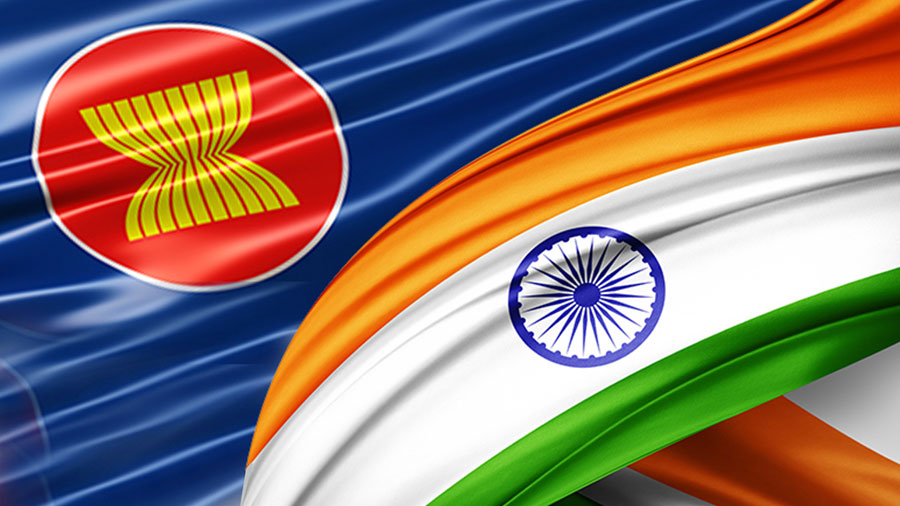The possibilities for cooperation between New Delhi and Southeast Asian countries are numerous. So is the potential for deepening the relationship.
By Aishwarya Nautiyal
With the emergence of Indian economic development and influence, one of the major focus of the policy makers has been on “Look East Policy” in which ASEAN has become a primary collaborative organization for implementing India’s trade, security and economic interests. One of the major agreements was the “Free Trade Agreement” which was signed by India and ASEAN in 2009, in Bali Indonesia. Changing global dynamics and the growing importance of the Indo-Pacific region brings this partnership as a core central focus point for stability and building sustainable coordination in a globalized world. A group of ten nations with variation in economic growth and abundance of resources have paved a way with 90% of tariff liberalization making it one of the largest FTAs in the world inclusive of some privileged products like palm oil, tea, coffee.
With India’s forecast of exporting 46$ billion in Financial Year 22 which is among the largest trading regions in meeting its target of 400$ billion globally. The main cooperation comes from the field of engineering where ASEAN holds 15% of share in Indian engineering exports which was recorded at 35.3$ billion in 2021 and with a new fiscal target of 105$billion in 2022. In the global scenario this cooperation is becoming an important value supply chain focused upon mutual partnership and export markets. ASEAN itself is positioned with the third largest exporting partner to India and fifth biggest trade partner. While looking at the rising interaction between two partners some alarm bells have been raised among Indian policy makers where it has been seen as tariff reduction is bringing larger participation of ASEAN in Indian markets compared to India’s participation in competitive markets of ASEAN economies. This is due to some of the major countries like Singapore, Malaysia & Indonesia being export driven economies with competitive advantage with higher export GDP ratio.
Kerala is one of the major exporters including domestic exports of plantation products. Rubber, coffee, fish being the largest source of income whereas lower productivity due to rising imports at competitive pricing is affecting its farming industry. One of the major hindrances can be seen with cheaper import of fish, rubber & palm oil from Malaysia & Indonesia which has already impacted local production and decline in its demand. Rising competition with the ASEAN imports has brought up certain challenges to the governance where they find it a mammoth task to keep the balance between local cultivation and trade liberalization. Another major challenge lies towards variation in ASEAN economic and political stability. Myanmar, which has seen a prolonged political turmoil and its borders with India have brought up new challenges concerning an alarm in New Delhi’s vision in South East Asia.
Another challenge that this cooperation has faced is the boycott of Malaysian palm oil export to India by traders which brought a huge concern among the member nations. Malaysia was seen by Indian policymakers with deliberate interference to its domestic affairs when the government of India revoked Kashmir’s special status in 2019. During this period Malaysian Prime Minister’s Mahathir Mohamad statement opposing the revocation brought a new rift due to which India imposed restrictions on palm oil imports from Malaysia. These political dynamics and certain flare up issues highlights one important aspect to be focused upon where large diplomatic coordination to implement major confidence building measures. Nevertheless, challenges and strategic interests have emerged and negotiations with multilateral dialogues are making sure new setups are placed to deal with such issues. Increasing importance of ASEAN and Indian Ocean brings up new avenues where disputes in the Pacific can be seen as a new focal point of enhancing strategic partnership and rectifying security dynamics.
The Malacca dilemma is one of the core aspects in which the Andaman & Nicobar islands (India) is placed strategically near the major trading route of Strait of Malacca sharing its geographic location with the key economies such as Thailand, Malaysia, Singapore and Indonesia, this makes India having maritime boundary with neighboring ASEAN countries. In recent years mutual cooperation has emerged in various fields of defense sectors including military exercises, defense technological development, arms trade and mutual infrastructure development. Malacca strait being one of the important trading routes which is located under supervision of regional states where mutual collaborations are promoted to ensure free navigation of international trading in accordance with international laws, also to promote and explore new business avenues in changing and challenging geopolitical scenarios. On the other hand India’s defense cooperation with Vietnam and first sale of supersonic Brahmos missiles to Philippines with participation of Tejas fighter jets for Malaysian Air Force is looked upon building trust in various dynamics of strategic and security cooperation sharing mutual concerns over regional disputes.
Strengthening multi-faceted relationship from political and security cooperation to social, cultural and lingual participation includes India’s new vision of “Act East Forum” for its north eastern states and its infrastructure development with the help of Japanese investments targeting its connectivity to neighboring ASEAN countries. Sittwe port in Rakhine province of Myanmar which has been developed aiming at infrastructure and transportation development and access to Bay of Bengal for landlocked North Eastern state of India of Mizoram and further inland. Another trilateral highway project connecting Moreh (India) via Mandalay (Myanmar) to Mae Sot (Thailand) is an example of India- ASEAN connectivity project with future plans to expand it to Laos, Cambodia and Vietnam. These projects have shown some interesting development from the Bangladesh government seeking an opportunity in India-ASEAN infrastructure development connecting Dhaka to boost connectivity, whereas it can also provide access to landlocked countries like Nepal and Bhutan to ASEAN members via North East India. Recognizing potential for mutual development can deepen and strengthen new avenues for the region, ensuring strong historical cultural linkage between regional partners and their rich mutual shared history.






